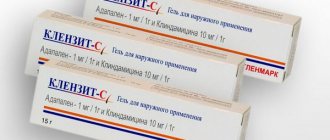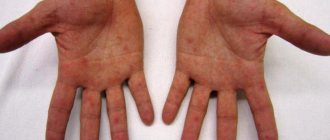Photo: gorzdrav.org Photo: 366.ru
Photo: medic.ru
Photo: yandex.ru
Minolexin is an antibiotic of the tetracycline group. Has a bacteriostatic effect. Active ingredient: Minocycline hydrochloride.
You need to know that Minolexin reduces the bactericidal effect of penicillins, and simultaneous use with oral contraceptives leads to a decrease in the effectiveness of the latter. Dispensed with a doctor's prescription!
Directions for use and doses
Take Minolexin orally after meals. It is recommended to drink plenty of liquid (maybe milk). reducing the risk of irritation and ulceration in the esophagus. The initial dose of Minolexin is 200 mg (2 capsules of 100 mg or 4 capsules of 50 mg), then take 100 mg (1 capsule of 100 mg or 2 capsules of 50 mg) every 12 hours (twice a day). The maximum daily dose should not exceed 400 mg.
- Infections of the genitourinary system and anogenital area caused by chlamydia and ureaplasma: 100 mg (1 capsule of 100 mg or 2 capsules of 50 mg) every 12 hours for 7-10 days.
- Inflammatory diseases of the pelvic organs in women in the acute stage: 100 mg (1 capsule of 100 mg or 2 capsules of 50 mg) every 12 hours, sometimes in combination with cephalosporins.
- Primary syphilis in patients. with hypersensitivity to penicillins: 100 mg (1 capsule of 100 mg or 2 capsules of 50 mg) twice a day for 10 - 15 days.
- Gonorrhea: 100 mg (1 capsule of 100 mg or 2 capsules of 50 mg) twice a day for 4-5 days, or 300 mg once.
- Uncomplicated gonococcal infections (excluding urethritis and anorectal infections) in men: initial dose - 200 mg (2 capsules of 100 mg or 4 capsules of 50 mg), maintenance dose - 100 mg (1 capsule of 100 mg or 2 capsules of 50 mg) after every 12 hours for at least 4 days, followed by a microbiological assessment of recovery 2-3 days after stopping the drug.
- Uncomplicated gonococcal urethritis in men: 100 mg (1 capsule of 100 mg or 2 capsules of 50 mg) every 12 hours for 5 days.
- Acne: 50 mg (1 capsule of 50 mg) per day, long course of 6-12 weeks.
Instructions for use of Minoleksin
| Active substance | Minocycline |
| pharmachologic effect | Bacteriostatic |
| Vacation conditions | Prescription |
| Release form | Capsules |
| Pregnancy and breastfeeding | According to indications |
| Age group | 8+ |
| Best before date | 2 years |
| Storage conditions | Not higher than +25°С |
| Analogs | Does not exist |
| Category | Antibacterial drugs |
| Manufacturer | ABVA RUS (RF) |
| Price | 546 - 1171 rub. |
Directions for use and dosage
Minolexin is taken orally after meals. It is recommended to take the capsules with a sufficient amount of liquid (milk) to reduce the risk of irritation and ulceration in the esophagus.
The initial dose of the drug Minolexin is 200 mg (2 capsules of 100 mg or 4 capsules of 50 mg), then take 100 mg (1 capsule of 100 mg or 2 capsules of 50 mg) every 12 hours (2 times /day). The maximum daily dose should not exceed 400 mg.
Infections of the genitourinary system and anogenital area caused by chlamydia and ureaplasma
Antibiotic Minolexin 100 mg (1 capsule of 100 mg or 2 capsules of 50 mg) every 12 hours for 7-10 days.
Inflammatory diseases of the pelvic organs in women in the acute stage
Prescribe 100 mg (1 capsule of 100 mg or 2 capsules of 50 mg) every 12 hours, sometimes in combination with cephalosporins.
Primary syphilis in patients with hypersensitivity to penicillins
Antibiotic Minolexin 100 mg (1 capsule of 100 mg or 2 capsules of 50 mg) 2 times a day for 10-15 days.
Gonorrhea
Prescribe 100 mg (1 capsule of 100 mg or 2 capsules of 50 mg) 2 times a day for 4-5 days, or a single dose of 300 mg.
Uncomplicated gonococcal infections (excluding urethritis and anorectal infections) in men
The initial dose of Minolexin is 200 mg (2 capsules of 100 mg or 4 capsules of 50 mg), maintenance dose is 100 mg (1 capsule of 100 mg or 2 capsules of 50 mg) every 12 hours for at least 4 days followed by microbiological assessment of recovery 2-3 days after stopping the drug.
Uncomplicated gonococcal urethritis in men
Prescribe 100 mg (1 capsule of 100 mg or 2 capsules of 50 mg) every 12 hours for 5 days.
Prescription for patients with normal and impaired renal function
While taking the drug, due to the anti-anabolic effect inherent in drugs of the tetracycline group, an increase in the level of urea in the blood plasma may be observed. In patients with normal renal function, this does not require discontinuation of the drug. In patients with severe renal impairment, azotemia, hyperphosphatemia and acidosis may develop.
In this situation, it is necessary to control the level of urea and creatinine in the blood plasma; the maximum daily dose of minocycline should not exceed 200 mg. The pharmacokinetics of minocycline in patients with renal failure (creatinine clearance less than 80 ml/min) has not yet been sufficiently studied to conclude that dose adjustment is necessary.
For liver dysfunction
Use Minolexin with caution.
Children over 8 years of age with infections caused by pathogens sensitive to minocycline
The initial dose is 4 mg/kg, then 2 mg/kg every 12 hours.
| Initial dose | Maintenance dose | |
| Children weighing more than 25 kg | 100 mg | 50 mg every 12 hours |
Minolexin for acne
The drug is 50 mg (1 capsule of 50 mg) per day, for a long course of 6-12 weeks.
Minolexin for acne
According to the instructions for medical use, the drug is indicated for the treatment of dermatological diseases such as acne and pimples. Minolexin is taken after meals with plenty of water. The doctor prescribes 50 mg (1 capsule of 50 mg) per day, for a long course of 6-12 weeks.
Compound
Minolexin 50 mg
- active ingredient: Minocycline hydrochloride 50 mg;
- excipients: microcrystalline cellulose - 73.5 mg, low molecular weight povidone - 8.75 mg, potato starch - 7 mg, magnesium stearate - 1.75 mg, lactose monohydrate - up to 175 mg;
- composition of the hard gelatin capsule: water - 13% -16%, quinoline yellow dye - 0.5833% -0.75%, sunset yellow dye (E110) - 0.0025% -0.0059%, titanium dioxide - 0, 9740% -2.0%, gelatin - up to 100%.
Minolexin 100 mg
- active ingredient: Minocycline hydrochloride 100 mg;
- excipients: microcrystalline cellulose - 147 mg, low molecular weight povidone - 17.5 mg, potato starch - 14 mg, magnesium stearate - 3.5 mg, lactose monohydrate - up to 350 mg;
- composition of the hard gelatin capsule: water - 13% -16%, titanium dioxide - 2.0% -2.1118%, gelatin - up to 100%.
The structural formula of Minocycline is C23H27N3O7. Photo: wikipedia.org
Indications for use
Minocycline hydrochloride is used to treat the following diseases, subject to the sensitivity of pathogenic microorganisms:
- acne;
- skin infections;
- spotted fever, typhoid fever, typhoid fever, Q fever (coxiellosis), vesicular rickettsiosis and tick fever;
- respiratory tract infections;
- lymphogranuloma venereum;
- psittacosis;
- trachoma (infectious keratoconjunctivitis);
- conjunctivitis with inclusions (paratrachoma);
- nongonococcal urethritis, infections of the cervical canal and anus in adults;
- cyclic fever;
- chancroid;
- plague;
- tularemia;
- cholera;
- brucellosis;
- bartonellosis;
- inguinal granuloma;
- syphilis;
- gonorrhea;
- yaws (tropical granuloma, non-venereal syphilis);
- listeriosis;
- anthrax;
- Vincent's angina;
- actinomycosis.
In the case of acute intestinal amebiasis, the use of Minocycline as an addition to amoebicidal drugs is allowed.
For severe acne, minocycline may be used as adjunctive therapy.
The use of minocycline is indicated for asymptomatic carriage of Neisseria meningitidis for the eradication of meningococci from the nasopharynx.
To prevent the emergence of resistance, the use of minocycline is recommended in accordance with the results of laboratory tests, including serotyping and determination of pathogen sensitivity. For the same reason, the use of minocycline for prophylactic purposes is not recommended in cases of high risk of meningococcal meningitis.
Clinical experience shows the effectiveness of minocycline in the treatment of Mycobacterium marinum infections, but at present these data are not confirmed by the results of controlled clinical trials.
Contraindications
- hypersensitivity to minocycline, tetracyclines and other components of the drug;
- porphyria;
- severe liver failure;
- severe renal failure;
- leukopenia;
- systemic lupus erythematosus;
- simultaneous use with isotretinoin;
- pregnancy;
- lactation period (breastfeeding);
- children under 8 years of age (period of dental development);
- lactase deficiency, lactose intolerance, glucose-galactose malabsorption.
Side effects
The spectrum of adverse events associated with minocycline does not differ from other tetracyclines.
- From the digestive system: anorexia, nausea, vomiting, diarrhea, dyspepsia, stomatitis, glossitis, dysphagia, hypoplasia of tooth enamel, enterocolitis, pseudomembranous colitis, pancreatitis, inflammatory lesions (including fungal) in the oral cavity and anogenital area, hyperbilirubinemia , cholestasis, increased activity of liver enzymes, liver failure, incl. terminal, hepatitis, including autoimmune.
- From the genitourinary system: vulvovaginal candidiasis, interstitial nephritis, dose-dependent increase in urea content in blood plasma, balanitis.
- From the skin: alopecia, erythema nodosum, nail pigmentation, itching, toxic epidermal necrosis, vasculitis, maculopapular and erythematous rash, Stevens-Johnson syndrome, exfoliative dermatitis.
- From the respiratory system: shortness of breath, bronchospasm, exacerbation of asthma, pneumonia.
- From the musculoskeletal system: arthralgia, arthritis, limited mobility and swelling of the joints, discoloration of bone tissue, muscle pain (myalgia).
- Allergic reactions: urticaria, angioedema, polyarthralgia, anaphylactic reactions (including shock), anaphylactoid purpura (Henoch-Schönlein purpura), pericarditis, exacerbations of systemic lupus, pulmonary infiltration accompanied by eosinophilia.
- From the hematopoietic system: agranulocytosis, hemolytic anemia, thrombocytopenia, leukopenia, neutrocytopenia, pancytopenia, eosinopenia, eosinophilia.
- From the central nervous system: convulsions, dizziness, numbness (including limbs), lethargy, vertigo, increased intracranial pressure in adults, headaches.
- From the senses: tinnitus and hearing impairment.
- From the metabolic side: a single case of malignant neoplasm of the thyroid gland, discoloration (according to the results of pathomorphological studies), dysfunction of the thyroid gland.
- Other: discoloration of the oral cavity (tongue, gums, palate), discoloration of tooth enamel, fever, discoloration of secretions (for example, sweat).
pharmachologic effect
Minolexin is a semisynthetic antibiotic from the tetracycline group. It has a bacteriostatic effect on cells of sensitive strains of microorganisms due to reversible inhibition of protein synthesis at the level of 30S ribosomal subunits. Minolexin has a wide spectrum of antibacterial activity.
Sensitivity of microorganisms:
- aerobic gram-positive - some of the microorganisms listed below have shown resistance to minocycline, so before use it is recommended to conduct laboratory sensitivity tests - Bacillus anthracis, Listeria monocytogenes, Staphylococcus aureus, Streptococcus pneumoniae. Antibiotics of the tetracycline group are not recommended for the treatment of streptococcal and staphylococcal infections unless sensitivity of microorganisms to minocycline is shown;
- aerobic gram-negative - Bartonella bacilliformis, Brucella species, Calymmatobacterium granulomatis, Campylobacter fetus, Francisella tularensis, Haemophilus ducrey, Vibrio cholerae, Yersinia pestis.
For the following microorganisms, sensitivity testing to Minocycline is strongly recommended: Acinetobacter species, Enterobacter aerogenes, Escherichia coli, Haemophilus influenzae, Klebsiella species, Neisseria gonorrhoeae, Neisseria meningitidis, Shigella species.
Additionally: Actinomyces species, Borrelia recurrentis, Chlamydia psittaci, Chlamydia trachomatis, Clostridium species, Entamoeba species, Fusobacterium nucleatum subspecies fusiforme, Mycobacterium marinum, Mycoplasma pneumoniae, Propionibacterium acnes, Rickettsiae, Treponema pallidum subspecies pallidum, Treponema pallidum subspecies pertenue, Ureaplasma urealyticum.
Precautionary measures
The antibiotic Minolexin should be prescribed with caution in case of impaired liver and kidney function, or the simultaneous use of hepatotoxic drugs.
Use of Minoleksin during pregnancy and breastfeeding
During pregnancy, it is recommended to prescribe Minocycline only in cases where the expected benefit from its use for the mother outweighs the potential risk to the fetus. During treatment with Minocycline, breastfeeding is suspended.
Use for liver dysfunction
The drug should be prescribed with caution in case of liver dysfunction. The use of the drug is contraindicated in severe liver failure.
Use for renal impairment
The drug should be prescribed with caution in case of impaired renal function. The use of the drug is contraindicated in severe renal failure.
Use of Minolexin in children
The use of antibiotics is contraindicated in children under 8 years of age (the period of dental development).
special instructions
- With long-term use of minocycline, the cellular composition of peripheral blood should be regularly monitored, liver function tests should be performed, and the concentration of nitrogen and urea in the serum should be determined.
- When using contraceptives with estrogens, additional contraceptives or a combination of contraceptives should be used during minocycline therapy.
- A false increase in the level of catecholamines in urine is possible when they are determined by the fluorescent method.
- When examining a biopsy of the thyroid gland in patients who have been receiving tetracyclines for a long time, one should take into account the possibility of dark brown staining of the tissue in micropreparations.
- While taking the drug and 2-3 weeks after stopping treatment, diarrhea caused by Clostridium dificile (pseudomembranous colitis) may develop. In mild cases, it is sufficient to discontinue treatment and use ion exchange resins (colestyramine, colestipol); in severe cases, replacement of loss of fluid, electrolytes and protein, and the appointment of vancomycin, bacitracin or metronidazole are indicated. Do not use medications that inhibit intestinal motility.
- To avoid the development of resistance, minocycline should be used only in accordance with the results of a sensitivity study of pathogenic microorganisms. If susceptibility testing of microorganisms is not possible, the epidemiology and susceptibility profile of microorganisms in a particular region should be taken into account.
- In the case of sexually transmitted diseases, if concomitant syphilis is suspected, before starting treatment it is necessary to conduct dark-field microscopy studies. Serological diagnostics of blood serum is recommended to be carried out at least once every 4 months.
- Periodic laboratory diagnostics of body functions is necessary, incl. hematopoietic and renal functions, as well as liver condition.
- Caution must be exercised when driving vehicles and engaging in other potentially hazardous activities that require increased concentration and speed of psychomotor reactions, due to the fact that minocycline has a side effect such as dizziness.
Algorithms of action in the event of some side effects from Minolexin
- if superinfection develops, minocycline should be discontinued and adequate therapy should be prescribed;
- if intracranial pressure increases, minocycline should be discontinued;
- Diarrhea is a common disorder associated with antibiotic use. If diarrhea occurs during treatment with minocycline, you should immediately consult a doctor;
- Tetracycline antibiotics cause increased sensitivity to direct sunlight and ultraviolet radiation. If erythema occurs, the antibiotic should be discontinued.
The principle of action of the drug. General information about it
Minolexin is a drug belonging to the group of antibiotics (tetracyclines), it is available in the form of capsules in a dosage of 50 or 100 mg. The price for 20 tablets of this product can vary from 400 to 600 rubles. They are sold in pharmacies and are available without a prescription, meaning anyone can purchase them. Additional positive properties of the drug include qualities such as:
- lack of interaction with food;
- excellent digestibility by the gastrointestinal tract;
- ability to accumulate in sebaceous ducts.
As a rule, Minolexin is prescribed for cosmetic purposes for severe acne on the face, shoulders and back. Its additional indications include skin infections, typhoid fever, fevers of various types and sore throat.
The main principle of the drug’s action is to destroy a number of bacteria that cause skin rashes. If acne occurs due to hormonal changes or excessive work of the sebaceous glands, such a medicine will not be effective. Unfortunately, many people are inattentive to the fact that capsules only have an antibacterial effect. Perhaps this is why you can find a number of negative reviews about this product on the Internet. There are opinions that capsules aggravate the situation or do not work at all.
Minolexin® (Minolexin)
With long-term use of minocycline, the cellular composition of peripheral blood should be regularly monitored, liver function tests should be performed, and the concentration of nitrogen and urea in the serum should be determined.
When using contraceptives with estrogens, additional contraceptives or a combination of contraceptives should be used during minocycline therapy.
A false increase in the level of catecholamines in urine is possible when they are determined by the fluorescent method.
When examining a biopsy of the thyroid gland in patients who have been receiving tetracyclines for a long time, one should take into account the possibility of dark brown staining of the tissue in micropreparations.
While taking the drug and 2-3 weeks after stopping treatment, diarrhea caused by Clostridium difficile (pseudomembranous colitis) may develop. In mild cases, it is sufficient to discontinue treatment and use ion exchange resins (colestyramine, colestipol); in severe cases, replacement of loss of fluid, electrolytes and protein, and the appointment of vancomycin, bacitracin or metronidazole are indicated. Do not use medications that inhibit intestinal motility.
To avoid the development of resistance, minocycline should be used only in accordance with the results of a sensitivity study of pathogenic microorganisms. If susceptibility testing of microorganisms is not possible, the epidemiology and susceptibility profile of microorganisms in a particular region should be taken into account.
In the case of sexually transmitted diseases, if concomitant syphilis is suspected, before starting treatment it is necessary to conduct dark-field microscopy studies. Serological diagnostics of blood serum is recommended to be carried out at least once every four months.
Periodic laboratory diagnostics of body functions, including hematopoietic and renal functions, as well as the condition of the liver, are necessary.
Algorithms for action in the event of certain side effects:
If superinfection develops, minocycline should be discontinued and adequate therapy should be prescribed.
If intracranial pressure increases, minocycline should be discontinued.
Diarrhea is a common disorder associated with antibiotic use. If diarrhea occurs during treatment with minocycline, you should immediately consult a doctor.
Antibiotics of the tetracycline group cause increased sensitivity to direct sunlight and ultraviolet radiation. If erythema occurs, you should stop taking the antibiotic.










